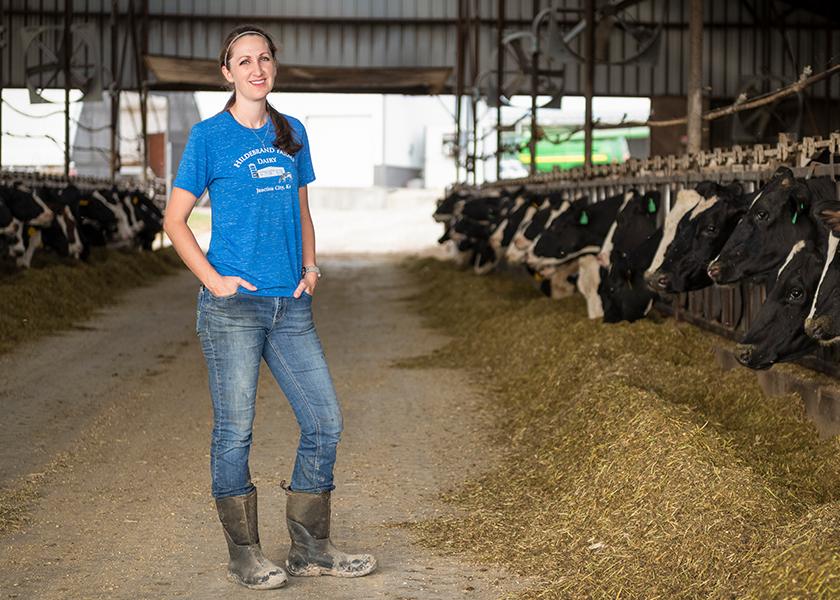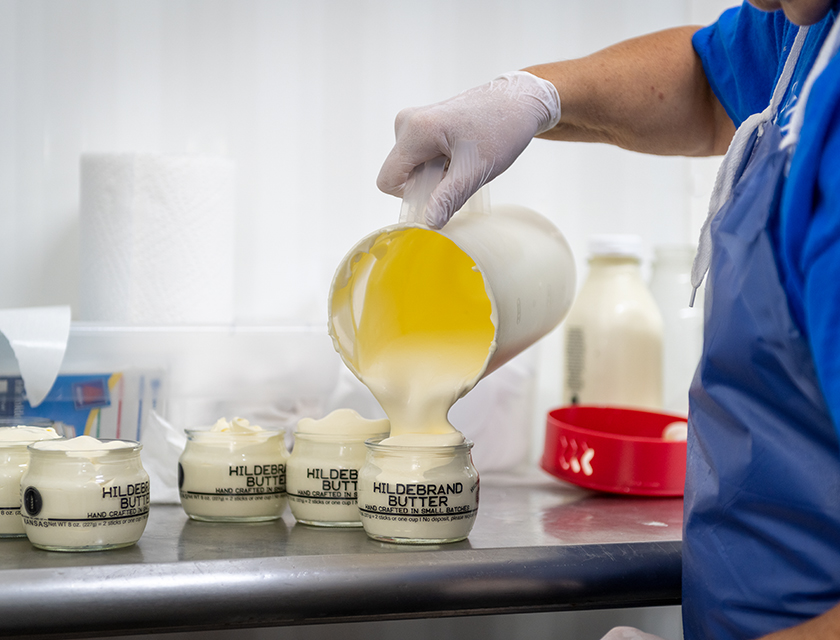Innovation Drives Sustainable Success

Clever. Creative. Leading edge. These words naturally come to mind when visiting Hildebrand Farms Dairy in Junction City, Kan., although Melissa Hildebrand-Reed would say they just try to do better every single day. In honor of their drive to do better in all things, Hildebrand Farms Dairy was named the International Dairy Foods Association (IDFA) 2022 Innovative Dairy Farmer of the Year.
The Hildebrand family has been at the forefront of innovation — from their processing plant to multifaceted industry partnerships to tapping into the A2 milk market. Each advancement has paved a sustainable path of success for this four-generation farm.
Farm History
Migrating from Switzerland to Kansas City, Mo., in 1920, Arnold Hildebrand began work as a machinist with the Union Pacific Railroad. After marrying his sweetheart, Rose, they moved with the railroad to Junction City. With a growing family, the couple wanted to earn more money so they started a small hobby farm. A decade later, they began selling milk. Arnold and Rose had seven children, six daughters and one son, Carl.
When Carl married in 1949, the farm was passed to him and his wife, Margaret. The couple had four children. When their sons expressed interest in continuing the farm legacy, Carl took out a loan in 1975 to build a freestall barn and parlor.
Today Hildebrand Farms is owned and operated by brothers David, and his wife, Kathy, and Alan, and his wife, Mary. Alan’s daughter Melissa serves as the operations manager and David’s son, Tod, offers a helping hand with the crop enterprise and assists with all the day-to-day operations.

Processing Plant
With the goal to create a fully sustainable farm, the Hildebrand family decided to build an on-site bottling plant in September 2008. The farm became members of Central Equity, who was willing to purchase any leftover milk.
“We were able to sell them what we had left, which initially was 90%,” Alan shares.
It took two years for the farm to use 75% of their milk in their bottling plant. Within four years, they were up to 100% capacity, which is not necessarily ideal because you don't want to outstretch your supply and demand, Alan says.
Today, they have a strategic milk marketing plan with a general rule of thumb to carry a small excess supply. The surplus is then used in a nearby cheese plant and, if they find themselves in a bind, Central Equity buys the milk.
“We are fortunate to still have that relationship,” Alan notes.
Appreciating the neighborly relationships, the Hildebrands return the favor when nearby creameries similar in size and scale are short on milk by supplying them with extra.
“Creating and maintaining those relationships is huge,” Melissa remarks.

Today, Hildebrand has nine varieties of milk and two varieties of butter in more than 150 stores throughout Kansas. Melissa shares the real motivation for processing their own milk was spurred by her father and uncle, who wanted to continue the farm’s legacy.
“I’m grateful to have a farm that I could come back to because I know so many people don’t have that opportunity,” she states.
With the changing tastes and diets of today’s consumers, the Hildebrands began refocusing their herd’s genetics two years ago by using sires with strong A2 traits.
“The No. 1 trait we select bulls for is A2A2. The second trait is butterfat,” Melissa says.
Understanding they are a voice for the industry, Alan says they never take the stance that their milk is healthier than others.
The Hildebrands open-door policy in their local community allows them to not only promote their products but educate the consumer about the dairy industry. More than 10,000 students tour the farm annually, and the farm hosts various events such as yoga on the farm, cows cooks and conservation, harvest festivals and “moo-vie” nights as well as operate a farm store on the dairy.
Industry Partnership
With the proximity of the USDA Research Center only 30 miles east in Manhattan, it paved the way for the Hildebrands to be at the forefront of national research and product development. Two years ago, a partnership was established between the USDA Research Center and Hildebrand Farms Dairy, focusing on researching the direct effects of mosquitoes on livestock.
“They were not only looking at the ways to trap and count mosquitoes, but also looking at devices essentially that could eliminate and ward off mosquitoes,” Melissa says.
The partnership has been a win-win for both the Hildebrands and USDA.
“The entomologists and biologists have incredible minds that want to make a difference for the dairy industry, but they have very little background or knowledge of the application to make it happen,” Melissa says. “So, in a way — they need us, more than we need them.”
One project spurred other project ideas and USDA asked Melissa if they could collect flies for a research project on her farm.
“Of course, we were all in, especially having customers visiting our farm, fly control is huge,” she reports.
Yet another USDA project included SCR monitoring tags on 40 initial animals to watch tail switches and ear movement.
“It’s just awesome,” Melissa notes. “Having research that benefits our farm, as well as the entire industry, is something we feel grateful to be part of.”
The Hildebrands have also worked with Kansas State University’s dairy plant to collaborate on various recipes for their butter and ice cream. They serve as an in-field teaching center for education opportunities with students from Kansas State University College of Veterinary Medicine and College of Agriculture. Many of those students then continue to advance through an on-farm internship program, which is also open to local veterans.
“We find great help from students and veterans who are eager to learn about farming and want to build their resumes,” Melissa adds.
Over the past decade, the Hildebrands have established a solid relationship with Kroger and currently have products in 53 of their grocery stores. They also have products in Sprouts, Natural Grocers, Whole Foods and Hy-Vee while continuing to supply local coffee shops and restaurants. In 2021, they started a partnership with a new company focused on door-to-door deliveries in Kansas City, Topeka and Lawrence with plans to expand into the Wichita metropolitan area.
The Future Road
The Hildebrands have been in business for more than nine decades because of their outside-the-box thinking to remain sustainable. Processing and selling milk direct to the consumer while showcasing the farm and entire industry became the focus of the small operation.
While facing the same challenges as other dairies, the Hildebrands are looking at robots to milk their cows in the future.
“Technology that can push us to the future — connecting with consumers is such a cool opportunity on showcasing what robots can do,” Melissa notes.
The farm milks 150 cows along with farming 1,850 acres of corn, soybeans and alfalfa. While the Hildebrands are always planning for future growth, they illustrate that growth doesn’t always have to equal more cows. The farm closely monitors the dollars and cents with products and distribution, focusing on the bottom line.
“Our growth can include more income per gallon of milk,” Alan says.
While there are twice as many dairy cows in Kansas as there were 20 years ago, one of the state’s relatively small dairies has been able to continue down the road of success without adding cows. Innovation and collaboration, not only within the industry, but in their local community as well, is what sets Hildebrand Dairy apart and gives them the title of Innovative Dairy Farmer of the Year.
“We try to make do with what we have, but also make it work well for us,” Melissa shares. “We simply try to follow God’s plan and do things the way they are intended and say yes when opportunities present themselves.”







